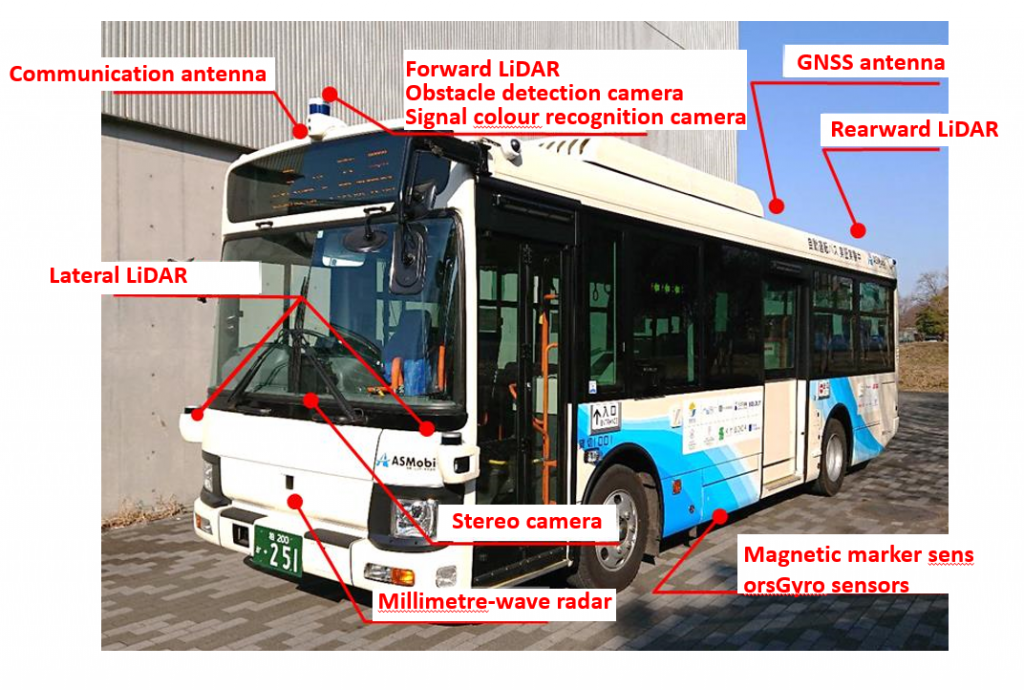The Kashiwa ITS Promotion Council has been conducting a commercial operation demonstration experiment using automated buses on a 2.6 km section between Kashiwanoha Campus Station on the Tsukuba Express and the University of Tokyo Kashiwa Campus since 1 November 2019 (Friday), and introduced a new vehicle in January 2021.
Based on the knowledge gained from the demonstration tests starting in 2019, Advanced Mobility Corporation will improve the automated driving system, increase sensing capabilities, improve ride comfort during acceleration and deceleration, and increase the size of the vehicle.
In addition, the vehicle will be newly equipped with the automated vehicle operation management platform Dispatcher developed by BOLDLY Corporation, which will add a remote status monitoring function, a driving instruction function, an emergency response function and a driving availability decision function, in addition to a driving record and error record function.
As in the past, verification of operation methods, operation, inspection and maintenance will be carried out in anticipation of practical operation over a long period of time, and studies will be carried out in conjunction with the development of new automated bus vehicles and the urban development of Kashiwanoha, with the aim of creating safe, comfortable and convenient services for residents.
New vehicle
Automatic driving system
- Lane keeping control
- GNSS (GPS)
- Magnetic marker sensor
- Speed maintenance control
- Accelerator, brake
- SRA function (distance control at all speeds)
- Traffic light coordination function (colour recognition by camera)
- Bus stop arrival and departure control
Vehicles
Base vehicle: Isuzu Elgamio
Capacity: 56 persons, 28 seated, 1 driver
※However, for the time being, the capacity is limited to 15 passengers to prevent the spread of new coronavirus infection.
Automated vehicle operation management platform Dispatcher
On-board functions that can be performed remotely
- Driving record function
- Error recording function
- Status monitoring function
- Driving instruction function
- Emergency response function
- Travelling advisable/unavoidable decision function
Scheduled route (part of approx. 2.6 km section)

Outline of the demonstration experiment
| Dates | From Friday 1 November 2019 to Thursday 31 March 2022 ※Operations may be cancelled due to weather, disasters, road conditions or other reasons. ※Operation is suspended on Saturdays, Sundays, public holidays and during the year-end and New Year holidays. |
|---|---|
| Operating hours | Four scheduled services between 11am and 3pm (including one special service). |
| Route | Tsukuba Express Kashiwanoha Campus Station – University of Tokyo Kashiwa Campus |
| Distance | Approx. 2.6 km (2.3 km on public roads, 0.3 km on campus) |
| Vehicles used | Automated vehicle based on the Isuzu Elgamio (general chartered operation) |
| Passenger capacity | 28 passengers (seated) ※However, to prevent the spread of new coronavirus infection, the maximum number of passengers is set at 15 for the time being. ※The vehicle will not run with a number of passengers in excess of the capacity. |
| Automatic operation level | Level 2 |
| Passengers |
Students, faculty and staff of the University of Tokyo Kashiwa Campus and visitors to the Kashiwa Campus. ※Only participants in the Kashiwanoha Smart City Tour [Gate Square Course] held at the Urban Design Centre Kashiwanoha (UDCK) are eligible to ride the above special service. ※For information on the status of applications and those wishing to board, please refer to the following website for details. https://www.kashiwanoha-smartcity.com/tour/pc/ |
Kashiwa ITS Promotion Council (Chairman: Professor Yoshihiro Suda, Institute of Industrial Science, University of Tokyo)
The Kashiwa ITS Promotion Council was established in December 2009 as a forum for cooperation and coordination between the University of Tokyo, administrative bodies, private companies, various organisations and individuals, with the aim of promoting various research and development activities and contributing to the commercialisation and practical application of these activities in order to realise a ‘low-carbon transport city’ and ‘next-generation environmental city’ using ITS in Kashiwa City. It was established in December 2009.
Outline of the definitions of the automation levels
| Level 1 | The system performs subtasks of vehicle motion control in either the longitudinal or lateral direction in a limited area. |
|---|---|
| Level 2 | The system performs both longitudinal and lateral vehicle dynamics control subtasks in a restricted domain |
| Level 3 | System performs all dynamic driving tasks in the restricted domain If it is difficult to continue the task, the system responds appropriately, e.g. to a request for system intervention. |
| Level 4 | System performs all dynamic operation tasks and responds to difficulties in continuing work in a restricted domain |
| Level 5 | The system performs all dynamic driving tasks and responses to cases where it is difficult to continue work without limitation (i.e. not in the limited domain). |
Participating organisations in automated bus demonstrations
The University of Tokyo Mobility Innovation Collaboration Research Institute, The University of Tokyo Institute of Industrial Science, The University of Tokyo Graduate School of Frontier Sciences, Kashiwa City, Advanced Mobility Corporation, Tobu Bus Central Corporation, Mitsui Fudosan Co Ltd, BOLDLY Corporation, Sompo Japan Insurance Inc, Mitsubishi Auto Leasing Co, Aichi Steel Corporation, IHI Corporation, Coit Electric Works Ltd, Nippon Signal Corporation, Kashiwanoha Urban Design Centre (UDCK), Pacific Consultants Inc.
Enquiries
<About automated buses and operations>
Secretariat, Mobility Innovation Collaboration Research Institute, The University of Tokyo
℡: 04-7136-6960
E-mail:utmobi-sec@its.iis.u-tokyo.ac.jp
<For information on the demonstration experiment as a whole>
Kashiwa ITS Promotion Council Secretariat (in Traffic Policy Division, Public Works Department, Kashiwa City)
℡:04-7167-1219
E-mail:kotsuseisaku@city.kashiwa.chiba.jp


